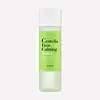What's inside
What's inside
 Key Ingredients
Key Ingredients

 Benefits
Benefits

 Ingredients Side-by-side
Ingredients Side-by-side

Water
Skin ConditioningCentella Asiatica Extract
CleansingButylene Glycol
HumectantDipropylene Glycol
HumectantGlycerin
HumectantPEG-40 Hydrogenated Castor Oil
EmulsifyingAllantoin
Skin ConditioningBetaine
HumectantXylitol
HumectantDipotassium Glycyrrhizate
Humectant1,2-Hexanediol
Skin ConditioningCaprylyl Glycol
EmollientIllicium Verum Fruit Extract
PerfumingChlorophyllin-Copper Complex
AntioxidantDisodium EDTA
Citric Acid
BufferingWater
Skin ConditioningMethylpropanediol
Solvent1,2-Hexanediol
Skin ConditioningSaccharide Hydrolysate
HumectantGlycereth-25 PCA Isostearate
EmulsifyingGluconolactone
Skin ConditioningEthylhexylglycerin
Skin ConditioningCentella Asiatica Leaf Water
Skin ConditioningHydroxyethylcellulose
Emulsion StabilisingDipotassium Glycyrrhizate
HumectantAllantoin
Skin ConditioningDisodium EDTA
Panthenol
Skin ConditioningCentella Asiatica Extract
CleansingCentella Asiatica Leaf Extract
Skin ConditioningCentella Asiatica Root Extract
Skin ConditioningButylene Glycol
HumectantHydrogenated Lecithin
EmulsifyingMelaleuca Alternifolia Leaf Water
AntimicrobialMadecassoside
AntioxidantGlycyrrhiza Uralensis Extract
EmollientEctoin
Skin ConditioningDipropylene Glycol
HumectantCaprylic/Capric Triglyceride
MaskingMelaleuca Alternifolia Leaf Extract
PerfumingCentella Asiatica Leaf
Skin ConditioningMyosotis Sylvatica Flower/Leaf/Stem Extract
Skin ConditioningHemerocallis Fulva Flower Extract
Skin ConditioningVegetable Amino Acids
Skin ConditioningSaccharide Isomerate
HumectantLactobacillus Ferment Filtrate
Skin ConditioningHydrolyzed Vegetable Protein
Skin ConditioningHouttuynia Cordata Extract
Skin ConditioningAsiaticoside
AntioxidantMadecassic Acid
Skin ConditioningAsiatic Acid
Skin ConditioningWater, Methylpropanediol, 1,2-Hexanediol, Saccharide Hydrolysate, Glycereth-25 PCA Isostearate, Gluconolactone, Ethylhexylglycerin, Centella Asiatica Leaf Water, Hydroxyethylcellulose, Dipotassium Glycyrrhizate, Allantoin, Disodium EDTA, Panthenol, Centella Asiatica Extract, Centella Asiatica Leaf Extract, Centella Asiatica Root Extract, Butylene Glycol, Hydrogenated Lecithin, Melaleuca Alternifolia Leaf Water, Madecassoside, Glycyrrhiza Uralensis Extract, Ectoin, Dipropylene Glycol, Caprylic/Capric Triglyceride, Melaleuca Alternifolia Leaf Extract, Centella Asiatica Leaf, Myosotis Sylvatica Flower/Leaf/Stem Extract, Hemerocallis Fulva Flower Extract, Vegetable Amino Acids, Saccharide Isomerate, Lactobacillus Ferment Filtrate, Hydrolyzed Vegetable Protein, Houttuynia Cordata Extract, Asiaticoside, Madecassic Acid, Asiatic Acid
Ingredients Explained
These ingredients are found in both products.
Ingredients higher up in an ingredient list are typically present in a larger amount.
1,2-Hexanediol is a synthetic liquid and another multi-functional powerhouse.
It is a:
- Humectant, drawing moisture into the skin
- Emollient, helping to soften skin
- Solvent, dispersing and stabilizing formulas
- Preservative booster, enhancing the antimicrobial activity of other preservatives
Allantoin is a soothing ingredient known for its protective and moisturizingg properties. Because of this, it is often added to products with strong active ingredients.
Studies show higher concentrations of this ingredient can promote wound healing.
Though it can be derived from the comfrey plant, allantoin is produced synthetically for cosmetic products to ensure purity.
Learn more about AllantoinButylene Glycol (or BG) is used within cosmetic products for a few different reasons:
Overall, Butylene Glycol is a safe and well-rounded ingredient that works well with other ingredients.
Though this ingredient works well with most skin types, some people with sensitive skin may experience a reaction such as allergic rashes, closed comedones, or itchiness.
Learn more about Butylene GlycolCentella Asiatica Extract (Centella) is derived from an herb native to Southeast Asia. It is famous for its anti-inflammatory and soothing properties.
Centella is rich in antioxidants and amino acids, such as Madecassic Acid and Asiaticoside.
Studies show the compounds in centella help with:
The combination of all these properties makes centella effective at soothing, hydrating, and protecting the skin.
Other great components of centella include Vitamin A, vitamin C, several B vitamins, and Asiatic Acid.
Fun fact: Centella has been used as a medicine and in food for many centuries. As a medicine, it is used to treat burns, scratches, and wounds.
Learn more about Centella Asiatica ExtractDipotassium Glycyrrhizate comes from licorice root.
Extracts of licorice have demonstrated to have antibacterial, anti‐inflammatory, antiviral, antioxidant properties.
One component, glabridin, has extra potent antioxidant and soothing properties. It has also been found to block pigmentation from UVB rays in guinea pigs.
Licorice Root also contains a flavonoid. Flavonoids are a natural substance from in plants. Flavonoids also have antioxidant properties.
Another component, glycyrrhizin, has been found to have anti-inflammatory and antimicrobial benefits. This may make licorice root extract effective at treating acne. However, more research is needed to support this.
Liquiritin is one of the flavone compounds found in licorice. It has been found to help lighten skin by preventing tyrosinase from reacting with tyrosine. When the two react, protein is converted to melanin. Melanin is the substance in your body that gives your features pigmentation.
Licorice root is native to Southern Europe and Asia. It has been used in traditional Chinese medicine to help with respiratory issues.
Learn more about Dipotassium GlycyrrhizateDipropylene Glycol is a synthetically created humectant, stabilizer, and solvent.
This ingredient helps:
Dipropylene glycol is technically an alcohol, but it belongs to the glycol family (often considered part of the ‘good’ alcohols). This means it is hydrating and gentle on skin unlike drying solvent alcohols like denatured alcohol.
As a masking agent, Dipropylene Glycol can be used to cover the smell of other ingredients. However, it does not have a scent.
Studies show Dipropylene Glycol is considered safe to use in skincare.
Learn more about Dipropylene GlycolDisodium EDTA plays a role in making products more stable by aiding other preservatives.
It is a chelating agent, meaning it neutralizes metal ions that may be found in a product.
Disodium EDTA is a salt of edetic acid and is found to be safe in cosmetic ingredients.
Learn more about Disodium EDTAWater. It's the most common cosmetic ingredient of all. You'll usually see it at the top of ingredient lists, meaning that it makes up the largest part of the product.
So why is it so popular? Water most often acts as a solvent - this means that it helps dissolve other ingredients into the formulation.
You'll also recognize water as that liquid we all need to stay alive. If you see this, drink a glass of water. Stay hydrated!
Learn more about Water